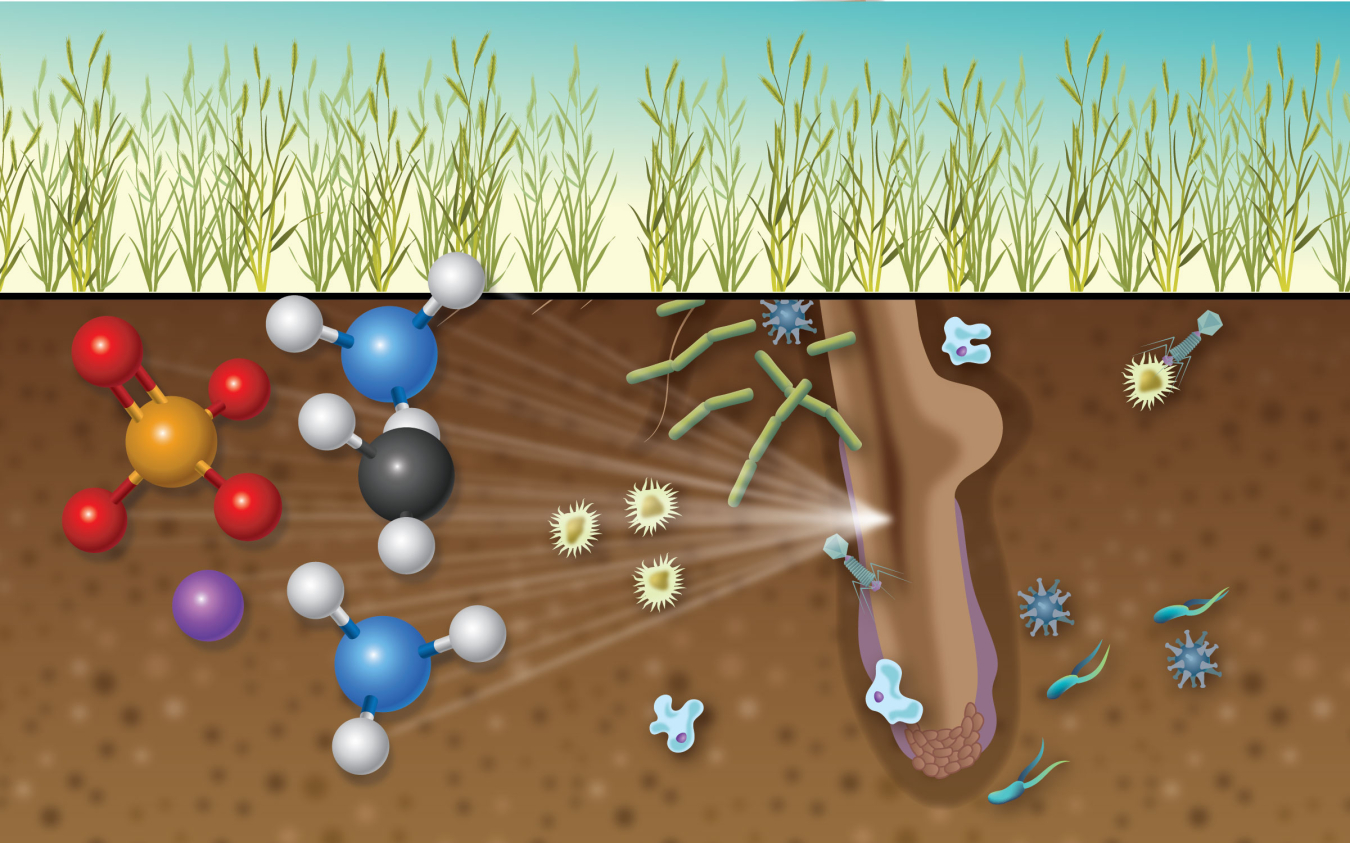
The plant microbiome is an assembly of microorganisms that live together in and near a plant and interact to form a microbial ecosystem. Microbiomes of all sorts interact closely with the living and non-living parts of their environment. In plants, the microbiome can make life possible by providing important services to the plant. It does so by interacting with soil, air, water, and plant roots. It’s similar to the human microbiome—the trillions of microbes in our bodies that can affect everything from weight gain to disease.
Scientists are only beginning to fully understand how microbial ecosystems form around plants and affect their growth. The plant microbiome can contain many thousands of different types of microorganisms, especially fungi and bacteria. Some of these microorganisms can’t survive without the plant host and the space, oxygen, water, proteins, and carbohydrates the plant provides. The specific microorganisms associated with a plant’s microbiome also often depend on a given plant’s species or its age, health, genes, and the surrounding soil environment. Two plants of the same species can sometimes have very different microbiomes.
The plant microbiome has three distinct domains – the phyllosphere, the endosphere, and the rhizosphere. The phyllosphere is on the aerial surface (especially the leaves and stem). The endosphere is inside the plant’s tissues—in other words, inside or between its cells. The rhizosphere is found in the soil around the root system of a plant.
In the rhizosphere, the plant microbiome can influence the type, rate, and amount of nutrients that plants can obtain from the soil and how well plants can use those nutrients. It can also help plants resist stress such as drought or diseases. This means that a plant’s fitness—its ability to grow, reach maturity, thrive, and reproduce—is the result of both the plant itself and its interaction with the microbiome.
Much of the energy that supports a plant’s microbiome starts with photosynthesis. This is the process plants use to convert sunlight, water, and carbon dioxide into oxygen and food, in the form of sugars that consist in part of molecules that contain carbon. Plants release these sugars and other compounds through their roots. Fungi and other microbes in the microbiome also help break down organic matter into simple chemical compounds that plants and other organisms in the microbiome can use. Sometimes plants make compounds that attract certain microbes. Scientists also speculate that plants sometimes communicate with their microbiomes through chemicals.
Scientists study plant microbiomes for many reasons. For example, the microbiome affects a plant’s health, sometimes protecting the plant and sometimes making a plant sick. Microbiomes also influence the yield of food, biofuels, and other plant products. A plant’s microbiome can affect how plants absorb carbon dioxide from the atmosphere, or how the soil stores carbon when plant organic material is broken down in the soil. This makes the plant microbiome an essential part of the carbon cycle and the Earth’s climate system.
DOE Office of Science: Contributions to Plant Microbiome Research
The Department of Energy (DOE), including the Office of Science, is closely involved with efforts to promote the bioeconomy. This is an economy that uses raw material from renewable biological resources for energy, chemicals, and other important materials. DOE focuses on crops for biofuels and other bioproducts, in contrast to plants for food. Because the plant microbiome is a huge part of the bioeconomy, the DOE Office of Science supports research on plant microbiomes through its Biological and Environmental Research program. The Office of Science’s Genomic Science Program supports research that uses genomic science, computer analysis, and experiments to better understand the ways plants and microbes interact. This helps scientists develop ways to improve the yield of biofuels crops, reduce their environmental impact, and potentially build on the ability of natural systems to store carbon and mitigate climate change. Meanwhile, the DOE Office of Science’s Environmental System Science Program is studying how broader ecosystems interact with the plant soil systems.
Fast Facts
- During droughts, the microbes in a plant’s microbiome can work together to survive.
- Scientists believe the Earth may be home to more viruses than there are stars in the Milky Way. A new approach helped to dramatically expand the number of known viruses in cottonwood tree microbiomes.
- Understanding the plant microbiome and what it releases into the air helps scientists understand particles that form clouds. That makes studying the microbiome important for climate and Earth system models.
Resources
- DOE Office of Science, Biological and Environmental Research program
- DOE’s Environmental Molecular Sciences Laboratory user facility houses a huge range of instruments and modeling resources for understanding biological and environmental systems
- DOE’s Joint Genome Institute user facility houses tools for studying the DNA of plants, microorganisms, and microbiomes
- The DOE Office of Science’s Environmental System Science Program supports research to understand terrestrial ecosystems. That includes plants and microbes.
- Read the DOE Office of Science, Biological Systems Science Division’s 2021 Strategic Plan
- Science highlight: The Inner Workings of the Root Microbiome
Scientific terms can be confusing. DOE Explains offers straightforward explanations of key words and concepts in fundamental science. It also describes how these concepts apply to the work that the Department of Energy’s Office of Science conducts as it helps the United States excel in research across the scientific spectrum.

